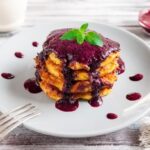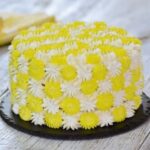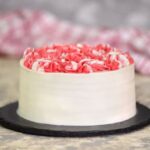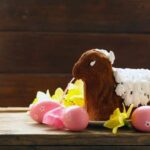Decorating a cake is an art that requires precision and creativity. And when it comes to elevating the appearance and taste of a cake, frosting plays a crucial role.
Whether you’re preparing a simple homemade treat or a show-stopping wedding cake, the type of frosting you choose can make all the difference. In this article, we will explore the world of frosting and provide you with step-by-step instructions on how to make the perfect frosting to decorate your cakes.
When it comes to cake decoration, homemade frosting is always the best choice. Not only does it allow you to control the flavors and consistency, but it also ensures that your creation is made with love and attention to detail. Additionally, homemade frosting offers greater versatility compared to store-bought alternatives – you can customize the flavors, colors, and textures according to your preferences or specific occasion.
Frosting not only enhances the presentation of a cake but also adds depth and richness to its flavor. From light and fluffy buttercream frosting to tangy cream cheese icing, there are numerous options available for every taste bud. The right choice of frosting can complement the flavors of your cake and create a harmonious balance that leaves everyone asking for seconds.
In this guide, we will explore different types of frostings and their unique characteristics. We will provide insights on choosing the right frosting for various styles of cakes as well as essential tips for mastering decorative techniques such as piping and spreading. Whether you’re a beginner or an experienced baker looking to expand your repertoire, this article will equip you with all the knowledge and skills needed to create stunning cakes using delicious homemade frostings.
Understanding the Basics
When it comes to cake decoration, frosting plays a crucial role in enhancing both the appearance and taste of a cake. Homemade frosting is often considered the best choice as it allows for greater control over flavors and textures. Additionally, frosting offers versatility in terms of creativity, making it an essential component of any visually appealing and delicious cake.
There are several main types of frosting to choose from, each with its own unique characteristics, uses, and flavors. Buttercream frosting is one of the most popular choices for cake decoration due to its creamy texture and ability to hold intricate designs. It can be flavored with extracts or infused with ingredients such as chocolate or fruit puree for added depth.
Another commonly used type is cream cheese frosting, which provides a tangy richness that pairs perfectly with carrot or red velvet cakes. Ganache frosting, made by combining chocolate and cream, offers a glossy finish and luxurious taste suitable for special occasions.
Choosing the right type of frosting for your cake style and occasion is crucial. For light and airy cakes such as sponge or angel food cake, a whipped cream-based frosting might be the best choice to complement the delicate flavors. On the other hand, denser cakes like chocolate or pound cakes can handle richer frostings like buttercream or ganache without overpowering the overall taste.
Gathering the Ingredients and Tools
When it comes to making homemade frosting, gathering the right ingredients and tools is crucial. Having all the necessary items on hand will ensure that your frosting turns out delicious and perfectly balanced in flavor and texture. Here is a comprehensive list of ingredients needed to make homemade frosting:
- Butter or Margarine: This is typically the base ingredient for most frostings. It adds richness and creaminess to the mixture.
- Confectioners’ Sugar: Also known as powdered sugar, it gives the frosting its sweetness and helps achieve a smooth consistency.
- Vanilla Extract: A classic flavoring for frostings, vanilla extract adds depth and enhances the overall taste.
- Milk or Cream: These liquids are used to thin out the frosting and adjust its consistency as needed.
- Salt: Just a pinch of salt can help balance out the sweetness in your frosting.
In addition to these main ingredients, there are optional ones that you can use depending on your desired flavor profile:
- Cocoa Powder: Perfect for chocolate frostings, cocoa powder adds richness and a deep chocolatey flavor.
- Cream Cheese: Used in cream cheese frostings, this ingredient brings a tangy taste and creamy texture to the mix.
Now that you have your ingredients ready, you’ll need a few essential tools and equipment:
- Mixing Bowl: Choose a large bowl that is big enough to comfortably mix all your ingredients together without any spillage.
- Electric Mixer or Stand Mixer: While you can certainly use a whisk, using an electric mixer or stand mixer will make whipping up your frosting much easier and quicker.
- Spatula or Wooden Spoon: These tools are handy for scraping down the sides of the mixing bowl as you go along with mixing your ingredients.
- Measuring Cups and Spoons: Accurate measurements are essential for achieving the perfect balance of flavors in your frosting.
- Piping Bags and Tips (optional): If you plan on using decorative piping techniques, having piping bags and different tips on hand will allow you to create intricate designs.
Now that you have your ingredients and tools ready, it’s time to move on to the next step – actually making the frosting.
The Perfect Buttercream Frosting
Buttercream frosting is a classic choice for cake decoration, known for its smooth and creamy texture. Making buttercream frosting from scratch allows for complete control over the ingredients and flavors. Here is a step-by-step guide to help you make the perfect buttercream frosting for your cakes:
Step 1: Gather Your Ingredients
Before you start making buttercream frosting, make sure you have all the necessary ingredients on hand. You will need:
- 1 cup (2 sticks) of unsalted butter, at room temperature.
- 4 cups of powdered sugar.
- 2 teaspoons of pure vanilla extract.
- Pinch of salt.
- 2 tablespoons of milk or heavy cream (optional, to adjust consistency).
Step 2: Creaming the Butter
In a large mixing bowl, beat the room temperature butter until it becomes smooth and creamy. Using an electric mixer on medium speed will make this process easier. Be patient as this step is crucial in achieving a fluffy and light consistency for your frosting.
Step 3: Gradually Add Sugar
Once the butter is creamy, gradually add in the powdered sugar. It’s important to do this in smaller increments to prevent lumps and ensure that each addition incorporates well into the mixture. Scrape down the sides of the bowl as needed.
Step 4: Flavoring Your Frosting
After adding all the sugar, mix in the vanilla extract and a pinch of salt to enhance the flavor profile of your buttercream frosting. You can also experiment with other extracts such as almond or lemon to add additional depth and complexity to your frosting.
Step 5: Adjust Consistency
If your frosting seems too thick, add milk or heavy cream tablespoon by tablespoon until it reaches your desired consistency. If you want stiffer frosting for piping decorative designs, omit the milk or cream. Remember to mix well after each addition until the desired texture is achieved.
Step 6: Frosting Your Cake
Once your buttercream frosting is ready, you can use a spatula or an offset icing knife to spread it onto your cake. Start by adding a thin layer of frosting as a crumb coat to seal in any loose crumbs. Then, apply a thicker and more even layer of frosting for the final coating.
By following these steps, you can create a smooth and delicious buttercream frosting to decorate your cakes. Feel free to experiment with different flavors and colors by adding extracts or food coloring during the process. The possibilities are endless, and with practice, you will be able to master the art of buttercream frosting decoration.
Cream Cheese Frosting
Cream cheese frosting is a delightful alternative to traditional buttercream frosting. It offers a tangy and creamy flavor that pairs perfectly with a variety of cake flavors. Whether you’re making a carrot cake, red velvet cake, or even a simple vanilla cake, cream cheese frosting can take your cake to the next level.
The Recipe
Making cream cheese frosting from scratch is surprisingly easy. Here’s a simple and delicious recipe to try:
Ingredients:
- 8 ounces cream cheese, softened.
- 1/2 cup unsalted butter, softened.
- 4 cups powdered sugar.
- 1 teaspoon vanilla extract.
Instructions:
- In a mixing bowl, beat the cream cheese and butter together until smooth.
- Gradually add the powdered sugar, one cup at a time, beating well after each addition.
- Add the vanilla extract and continue to beat until the frosting is light and fluffy.
- If necessary, refrigerate the frosting for 15 minutes before using to firm it up slightly.
Pairings and Occasions
Cream cheese frosting pairs exceptionally well with certain cake flavors. Its tangy taste complements rich and moist cakes like carrot cake or red velvet cake. The creamy texture of cream cheese frosting also makes it an excellent choice for layer cakes and cupcakes.
Cream cheese frosting is often associated with holidays such as Thanksgiving or Christmas due to its frequent pairing with spiced cakes like pumpkin or gingerbread. However, it can also be used for other occasions throughout the year. For example, pairing it with lemon or strawberry-flavored cakes creates a refreshing combination perfect for spring or summer celebrations.
Taking Frosting to the Next Level
One of the great things about making homemade frosting is the ability to customize and elevate its flavors. By incorporating different flavorings and additions, you can take your frosting to the next level and create unique and delicious combinations. There are various ways to achieve this, from using extracts to adding chocolate or fruits.
To start, consider using flavored extracts to enhance the taste of your frosting. Vanilla extract is a classic choice that pairs well with most cake flavors. However, you can also experiment with other extracts such as almond, mint, lemon, or even coconut. Just a few drops can make a big difference in the overall flavor profile of your frosting.
If you’re a chocolate lover, why not add cocoa powder or melted chocolate to your frosting? This will give it a rich and indulgent taste that complements chocolate cakes perfectly. You can also try white chocolate for a sweeter and creamier variation.
Adding fruits to your frosting can bring freshness and subtle sweetness to your creations. Puree berries or citrus fruits and mix them into your buttercream for a burst of flavor. Alternatively, try incorporating small pieces of fruit into cream cheese frosting for added texture and tanginess.
It’s important to note that when adding additional ingredients to your frosting, you may need to adjust the consistency. For example, adding liquid-based ingredients like purees or extracts may require more powdered sugar to maintain a thick consistency suitable for piping or spreading.
By experimenting with different flavorings and additions in your homemade frosting, you can truly showcase your creativity and personalize each cake you decorate. Don’t be afraid to mix and match flavors or try out new combinations – after all, that’s part of the fun.
Whether it’s a classic vanilla buttercream with a touch of almond extract or a refreshing lemon cream cheese frosting with fresh raspberries folded in, the possibilities are endless when it comes to taking your frosting game to the next level. Let your imagination run wild.
Mastering Decorative Techniques
Decorating a cake with frosting is an art form that allows you to showcase your creativity. Mastering decorative techniques can take your cake decoration skills to the next level and impress your friends and family. In this section, we will explore various frosting application techniques such as piping, spreading, and beyond.
Piping
Piping is a popular technique used to create intricate designs on cakes. It involves using a piping bag fitted with different tips to pipe frosting onto the cake in various patterns and shapes. Here are some key steps for mastering the art of piping:
- Choose the right piping tip: Different tips produce different shapes and patterns. Some popular choices include round tips for dots or lines, star tips for rosettes or borders, and petal tips for flower decorations.
- Fill the piping bag: Prepare your desired frosting and fill it into a disposable or reusable piping bag. Make sure to twist the top tightly to prevent any frosting from leaking out.
- Practice pressure control: Applying consistent pressure while piping is crucial for achieving clean lines and even designs. Start practicing on a piece of parchment paper before moving onto the actual cake.
- Experiment with different techniques: Try different motions such as rosettes, shells, borders, or writing to create unique designs. Don’t be afraid to get creative with your piping.
Spreading
Spreading frosting onto a cake may sound simple, but it requires precision and technique to achieve a smooth finish. Here are some tips for mastering the spreading technique:
- Cake crumb coat: Before applying the final layer of frosting, apply a thin layer called a crumb coat. This helps seal in any loose crumbs and provides a smooth base for the final layer.
- Start from the top: Begin by spreading a generous amount of frosting on top of the cake. Use an offset spatula to spread it evenly, starting from the center and working towards the edges.
- Sides and edges: Once the top is covered, move on to the sides of the cake. Hold the offset spatula at a slight angle and rotate the cake as you spread the frosting, working your way around.
- Smooth finish: To achieve a smooth finish, dip an offset spatula or bench scraper in hot water, wipe it dry, and gently glide it along the frosted cake’s surface. This will help remove any imperfections and create a clean look.
Beyond Piping and Spreading
While piping and spreading are common techniques for cake decoration, there are many other creative ways to enhance your cakes with frosting. Here are some ideas to take your decorating skills beyond traditional methods:
- Frosting flowers: Learn how to create beautiful flowers using different piping tips. Practice making rosebuds, daisies, or hydrangea blooms to add an elegant touch to your cakes.
- Ombre effect: Create a gradient effect on your cake by using different shades of frosting. Start with dark color at the bottom and gradually lighten as you move up for a stunning ombre design.
- Textured finishes: Experiment with textured finishes such as ruffles, waves, or basket weave patterns for a unique and eye-catching appeal.
By mastering these decorative techniques, you can elevate your cake decoration game and create confectionery works of art. Remember to practice patience and have fun while exploring different frosting styles and techniques – after all, decorating cakes with delicious homemade frosting is not only about perfect presentations but also about expressing your creativity.
Advanced Tips for a Picture-Perfect Finish
When it comes to frosting a cake, achieving a flawless finish is the key to creating an impressive and professional-looking dessert. With some advanced tips and techniques, you can elevate your cake decorating skills and take your frosting to the next level. Here are some expert suggestions to help you achieve a picture-perfect finish:
- Getting Smooth Sides: One of the challenges in frosting a cake is achieving smooth sides. To achieve this, start by applying a thin layer of frosting (also known as a crumb coat) to the cake and refrigerate it until firm. This initial coat will prevent crumbs from mixing into your final layer of frosting.
Once chilled, apply another layer of frosting, using an offset spatula to evenly spread it across the sides. To achieve perfectly smooth sides, hold the spatula at a slight angle against the cake while spinning it on a turntable. - Sharp Edges: Sharp edges give cakes that polished and professional look. After applying the final layer of frosting, use a bench scraper or icing smoother held at a 45-degree angle against the side of the cake to remove any excess frosting and create sharp edges. Start from the top and work your way down while turning the turntable slowly for consistent results.
- Professional Piping Work: Piping adds an elegant touch to any cake decoration. To ensure clean lines and intricate designs, use a piping bag fitted with different tips depending on the desired effect – round tips for dots or lettering, star tips for rosettes or borders, and petal tips for flowers. Practice piping techniques on parchment paper before moving onto your cake to ensure precision in your designs.
- Unique Frosting Designs: Take your creativity to new heights by exploring innovative techniques for unique frosting designs. Try using stencils to create patterns or using different colored frostings for ombré or marbled effects. You can also experiment with textured finishes such as ruffles, waves, or basket weave by using specialized piping tips. Don’t be afraid to let your imagination run wild and create stunning, eye-catching designs that showcase your personal style.
By incorporating these advanced tips into your cake decorating repertoire, you’ll be well on your way to achieving a picture-perfect finish every time. Remember, practice makes perfect, so don’t be discouraged if it takes a few tries to master these techniques. Enjoy the process of experimenting with different frosting styles and techniques, and most importantly, have fun showcasing your creativity with homemade frosting.
Conclusion
In conclusion, homemade frosting is a crucial element in cake decoration, as it not only enhances the appearance but also adds a delicious taste to any cake. Throughout this article, we have explored different types of frosting, learned how to make the perfect buttercream and cream cheese frostings, and discovered various decorative techniques. By incorporating unique flavorings and add-ons, you can truly showcase your creativity and create stunning cakes that are sure to impress.
Homemade frosting offers endless possibilities for customization and experimentation. Whether you prefer the classic buttercream or the tangy cream cheese frosting, there is a style to suit every cake flavor and occasion.
Don’t be afraid to get creative with extracts, fruits, chocolates, or even edible flowers to elevate your frosting’s flavor profile. Moreover, by adjusting the consistency of your frosting to suit different decorative techniques like spreading or piping, you can take your cake designs to the next level.
As you master new skills in frosting application techniques such as piping or spreading, don’t forget to focus on achieving a flawless finish. Smooth sides, sharp edges, and professional-looking piping work can greatly enhance the overall presentation of your cake. Take advantage of advanced tips shared throughout this article to achieve picture-perfect results. Remember that practice makes perfect; so keep experimenting with different designs and techniques until you are confident in showcasing your creative talent.
With homemade frosting as your canvas, decorating cakes becomes an enjoyable process of self-expression. So go ahead and let your imagination run wild. Share photos of your creations on social media platforms or host fun baking parties with friends and family.
The joy of cake decoration lies not only in the final product but also in the journey itself. So embrace the artistry behind homemade frosting and make every occasion memorable with beautifully decorated cakes that are both visually pleasing and irresistibly delicious.
Frequently Asked Questions
What kind of frosting do you use to decorate a cake?
When it comes to decorating a cake, there are various types of frosting that can be used, depending on the desired outcome. One popular option is buttercream frosting, which is made by beating together butter and powdered sugar until light and fluffy. This versatile frosting can be easily flavored and tinted to create different effects.
Another common choice is cream cheese frosting, which combines cream cheese and powdered sugar for a tangy and creamy finish. Whipped cream frosting is also a favorite, made from whipped heavy cream sweetened with powdered sugar. It gives cakes a light and airy texture with a subtle sweetness.
How to make a cake frosting at home?
Making cake frosting at home can be a simple yet rewarding process. A basic recipe for buttercream frosting involves beating softened butter until creamy before gradually adding powdered sugar until the desired consistency is reached. Vanilla extract or other flavorings can then be incorporated for added taste.
If the frosting seems too thick, it can be thinned out with milk or water, while extra powdered sugar can thicken it if needed. It’s important to beat the mixture thoroughly to ensure a smooth and velvety texture.
How to make icing for a cake for beginners?
For beginners looking to make icing for a cake, a straightforward option is using powdered sugar glaze or drizzle icing. This type of icing only requires two ingredients — powdered sugar and liquid (such as milk or lemon juice) — mixed together until smooth.
The ratio between the two components varies depending on personal preference and desired consistency; adding more liquid creates a thinner icing ideal for drizzling, while less liquid yields a thicker glaze that sets nicely on the cake surface. This simple icing can be poured over the cake once it has cooled slightly or applied using an offset spatula to achieve an even layer of coverage.

Welcome to my blog about home and family. This blog is a place where I will share my thoughts, ideas, and experiences related to these important topics. I am a stay-at-home mom with two young children. I hope you enjoy reading it! and may find some helpful tips and ideas that will make your home and family life even better!





